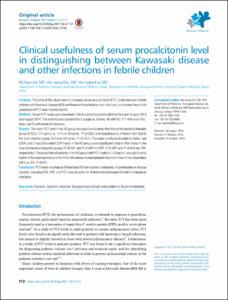Clinical usefulness of serum procalcitonin level in distinguishing between Kawasaki disease and other infections in febrile children
- Affiliated Author(s)
- 최희정
- Alternative Author(s)
- Choi, Hee Joung
- Journal Title
- Korean Journal of Pediatrics
- ISSN
- 1738-1061
- Issued Date
- 2017
- Abstract
- Purpose: The aims of this study were to compare serum procalcitonin (PCT) levels between febrile
children with Kawasaki disease (KD) and those with bacterial or viral infections, and assess the clinical
usefulness of PCT level in predicting KD.
Methods: Serum PCT levels were examined in febrile pediatric patients admitted between August 2013
and August 2014. The patients were divided into 3 groups as follows: 49 with KD, 111 with viral infections,
and 24 with bacterial infections.
Results: The mean PCT level in the KD group was significantly lower than that in the bacterial infection
group (0.82±1.73 ng/mL vs. 3.11±6.10 ng/mL, P=0.002) and insignificantly different from that in
the viral infection group (0.23±0.34 ng/mL,P=0.457). The mean erythrocyte sedimentation rate
(ESR) and C-reactive protein (CRP) level in the KD group were significantly higher than those in the
viral and bacterial infection groups (P<0.001 and P<0.001 for ESR, P<0.001 and P=0.005 for CRP,
respectively). The proportion of patients in the KD group with PCT levels of >1.0 ng/mL was significantly
higher in the nonresponders to the initial intravenous immunoglobulin treatment than in the responders
(36% vs. 8%, P=0.01).
Conclusion: PCT levels may help to differentiate KD from bacterial infections. A combination of disease
markers, including ESR, CRP, and PCT, may be useful for differentiating between KD and viral/bacterial
infections.
- Department
- Dept. of Pediatrics (소아청소년학)
- Publisher
- School of Medicine
- Citation
- Na Hyun Lee et al. (2017). Clinical usefulness of serum procalcitonin level in distinguishing between Kawasaki disease and other infections in febrile children. Korean Journal of Pediatrics, 60(4), 112–117. doi: 10.3345/kjp.2017.60.4.112
- Type
- Article
- ISSN
- 1738-1061
- Appears in Collections:
- 1. School of Medicine (의과대학) > Dept. of Pediatrics (소아청소년학)
- 파일 목록
-
-
Download
 oak-2017-0296.pdf
기타 데이터 / 592.92 kB / Adobe PDF
oak-2017-0296.pdf
기타 데이터 / 592.92 kB / Adobe PDF
-
Items in Repository are protected by copyright, with all rights reserved, unless otherwise indicated.